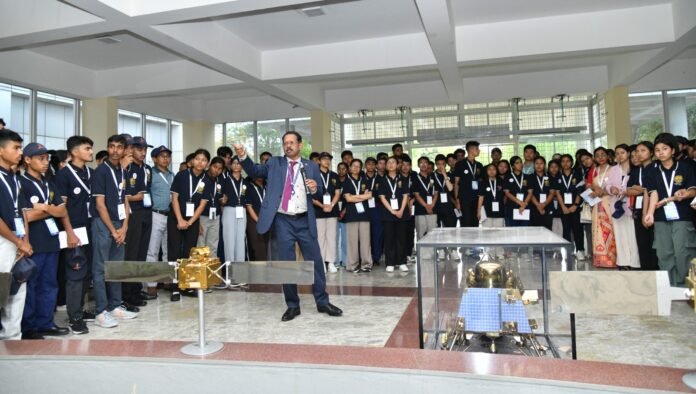In a significant initiative aimed at fostering scientific curiosity and encouraging careers in space sciences among youth from India’s Northeast, 800 students from eight northeastern states have recently visited various facilities of the Indian Space Research Organisation (ISRO) in Bengaluru.
800 Northeast Students Visit ISRO Centres Under NE-SPARKS Initiative
The visits were part of the North East Students’ Programme for Awareness, Reach, and Knowledge on Space (NE-SPARKS), a flagship educational outreach initiative launched jointly by ISRO, the North Eastern Council (NEC), and the governments of the northeastern states.
The NE-SPARKS programme was conceptualized following directives from Union Home Minister Amit Shah, who also serves as the President of the North Eastern Space Applications Centre (NESAC) Society. The initiative reflects the government’s broader vision of integrating the Northeast into India’s developmental and technological mainstream, especially in the field of space science and research.
According to ISRO officials, the programme was designed to provide an immersive experience for students, offering firsthand exposure to India’s cutting-edge space technology and research infrastructure. The programme is structured into eight batches, with each batch consisting of 100 students — one from each of the eight northeastern states: Assam, Arunachal Pradesh, Meghalaya, Manipur, Mizoram, Nagaland, Sikkim, and Tripura.
Engaging with Space Science Up Close
The visits to ISRO centres in Bengaluru were conducted in multiple phases. The space agency confirmed that the second and third batches of the NE-SPARKS programme visited the facilities on June 26–27 and July 24–25, respectively, with earlier and subsequent batches scheduled similarly. Each batch is carefully selected in collaboration with the respective state governments, ensuring the participation of meritorious and enthusiastic students with an interest in science, technology, engineering, and mathematics (STEM).
On the first day of their two-day visit, the students were taken to the ISRO Telemetry, Tracking and Command Network (ISTRAC) and the Indian Deep Space Network (IDSN). These facilities play a pivotal role in managing the telemetry, tracking, and command operations of all ISRO satellites and space missions, including lunar and interplanetary ventures.
During their time at ISTRAC and IDSN, the students interacted with senior scientists and engineers who explained the intricacies of deep space communication, satellite telemetry, and data acquisition. The sessions were designed to inspire and inform, giving the students a deeper understanding of how India tracks and communicates with satellites orbiting Earth and even spacecraft venturing into deep space.
“These interactions offered invaluable exposure. The students got a glimpse of how India manages its space assets and conducts interplanetary missions — something that’s rarely accessible at such a close level,” an ISRO spokesperson said.
Inside India’s Satellite Assembly Hub
The second day of the programme featured a visit to the U.R. Rao Satellite Centre (URSC), ISRO’s primary satellite development and integration facility. Here, students were given an overview of the complex processes involved in the designing, building, assembling, and testing of satellites before they are launched into orbit.
They learned about the different types of satellites developed by ISRO — including communication, navigation, Earth observation, and scientific satellites. The facility tour also included demonstrations and models to help students understand payload integration, thermal testing, and simulation procedures.
“This was the highlight of the trip for many,” said a teacher accompanying the student batch from Nagaland. “Many of these students come from remote towns where access to such advanced science infrastructure is limited. To witness it up close has been nothing short of transformative.”
A Gaganyaan Glimpse at Jawaharlal Nehru Planetarium
The visit concluded with a screening at the Jawaharlal Nehru Planetarium, where the students watched an educational film on India’s upcoming Gaganyaan mission — the country’s ambitious human spaceflight programme. The film offered insights into astronaut training, spacecraft design, and the goals of sending Indian astronauts to space in the coming years.
The experience, as described by students, left a lasting impression. “I always wanted to know what goes behind a space mission. Seeing the Gaganyaan film made me feel like this dream isn’t so far-fetched,” said Priyanka Das, a Class 11 student from Assam.
A Vision for Inclusion and Inspiration
The NE-SPARKS initiative is not just about showcasing ISRO’s achievements. It is a calculated step towards inspiring a new generation of space scientists, engineers, and innovators from the Northeast, a region often underrepresented in national-level science and technology platforms.
Union Home Minister Amit Shah, while presiding over the 12th meeting of the NESAC Society last year, had stressed the importance of nurturing talent from the Northeast and integrating them into India’s larger development journey. NE-SPARKS is one of several initiatives to fulfill that commitment, with the North Eastern Council playing a critical coordinating role.
A senior ISRO official noted, “India’s strength lies in its diversity — and scientific progress must reflect that. Programmes like NE-SPARKS ensure that the youth of the Northeast are not just spectators but active participants in our space journey.”
The Road Ahead
Following the positive reception of the initial batches, ISRO plans to continue the programme with more visits, interactive sessions, and potentially, long-term mentoring opportunities for promising students. The participating states are also being encouraged to set up space clubs and innovation labs in schools, leveraging the momentum generated by these visits.
State education departments have praised the programme’s impact, noting improved student engagement in STEM-related subjects and a surge in interest around space science and careers in research and engineering.
For now, the excitement remains fresh among the 800 students who returned home with memories, knowledge, and dreams. As one student from Sikkim put it:
“This wasn’t just a visit to ISRO. It was a visit to our future.”
ALSO READ: Nation on High Alert: Key Developments Across India on July 29, 2025












